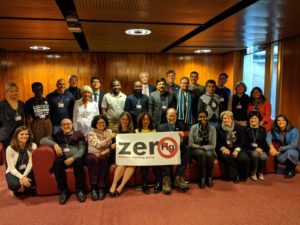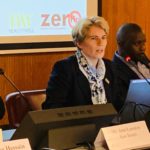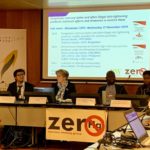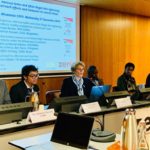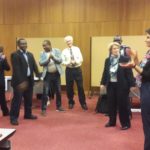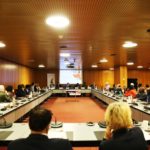Third Conference of the Parties of the Minamata Convention on Mercury (COP3)
25-29 November 2019, Geneva, Switzerland.
All UN Environment relevant documents and details about the meeting can be found at the dedicated UNEP webpages.
ZMWG views on COP3 decisions
This paper summarizes the recommendations of the Zero Mercury Working Group (ZMWG) on the anticipated decisions at the third Conference of the Parties (COP 3). We highlight only the priority issues, and the key points on these issues. We encourage COP 3 delegates to consult with ZMWG representatives for more details or positions on documents not discussed below.
In the following document you can find the preliminary ZMWG recommendations on:
- The review of the Annex A and B
- The development of guidance for inventories of mercury releases to land and water under Article 9
- Setting Waste Thresholds under Article 11
You can also find these recommendations in Spanish and French.
ZMWG statements at COP3

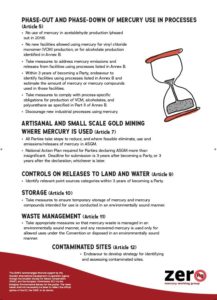
ZMWG blog
Summary of the Third Conference of the Parties for the Minamata Convention on Mercury
25-29 November, 2019, Geneva, Switzerland.
The Zero Mercury Working Group (ZMWG) closely followed the Third Conference of the Parties for the Minamata Convention on Mercury (COP3) in Geneva, Switzerland, 25-29 November 2019. Our main priorities included, having COP3 establish a process to review Annex A and B, enhance harmonised customs codes and address waste thresholds, releases and effectiveness evaluation. We also closely followed matters such as capacity building, the Implementation and Compliance Committee and Programme of Work and Budget.
COP3 made several decisions along the lines of our recommendations, among others, on:
Review Annexes A and B: A process was put in place to review and potentially enlarge the scope of mercury added products and processes to be phased out, with the assistance of an intersessional expert group that includes participation by NGOs;
Dental Amalgam: Several African countries proposed to amend the Convention to phase out dental amalgam, initially for children and eventually for all. In its decision, COP3 encouraged Parties to carry out more than the two required measures to phase down the use of mercury. It further requested the Secretariat to collect relevant information from parties and others and to compile and present the information received prior to COP4.
Custom Codes: The COP requested the secretariat to continue its work in collaboration with UNEP Products Partnership, and involving relevant experts, to draft a guidance document for consideration at COP 4 that includes enhancing harmonized customs codes to better identify mercury added products;
Releases: The COP designated wastewater discharges to land and water as releases subject to Article 9, and on the basis of this guidance requested the group of technical experts (established under COP 2) to continue to work intersessionally, with the possibility of one face-to-face meeting, towards identifying and outlining steps to control releases to land and water.
Waste thresholds: The COP approved the lists of wastes ‘consisting of’ and ‘containing’ mercury or mercury compounds and decided no thresholds are needed for these wastes. The COP also requested that the expert group continue the work towards developing waste thresholds for ‘waste contaminated by mercury or mercury compounds’, and for the tailings from non-ferrous mining operations (other than primary mining) currently excluded from Convention coverage. Along our views, the expert group was also mandated to discuss separately how to handle tailings from the artisanal and small-scale gold mining sector, evaluating whether a ‘no threshold’ approach can be taken to this category.
Contaminated sites: The COP adopted guidance on the management of contaminated sites and instructed the secretariat to continue collecting relevant information. The guidance encouraged Parties to identify, assess, manage, and, as appropriate, remediate sites contaminated by mercury or mercury compounds. The Guidance may need to be revised in the future to ensure that it continues to reflect best practice.
Effectiveness evaluation: While a list of indicators and a framework of work were presented by the expert group, the work did not conclude as expected. The COP was unable to get agreement for a decision, nor did it manage to agree on a concrete intersessional process before COP 4. In the end, it only called for a collection of views on the indicators to be compiled by the Secretariat and services to be requested in the development of draft guidance on monitoring among other reports.
Other issues: Other issues that were covered included a request for further information on capacity building, technical assistance and technology transfer as well as on emissions from open burning. Also, the Implementation and Compliance Committee adopted its terms of reference. Finally, a new president, Rosa Vivien Ratnawati (Indonesia), was elected for COP 4, along with new Bureau members.
ZMWG activities: More than 25 ZMWG colleagues from around the globe attended COP3 and provided input to our various activities and interventions. The ZMWG had an exhibition booth highlighting our work, including detailing the immediate obligations of the Parties and making available in USB sticks tools to facilitate understanding and implementation of the provisions of the Convention. During the second day of negotiations, Earth News Bulletin stopped by to discuss our work. You can see the full interview here. Furthermore, we had the opportunity to organise a side event to present two reports under our Skin Lightening Cream campaign. Images of the side event can be found here.
The ZMWG looks forward to a productive intersessional period and a fourth meeting of the Conference of the Parties (COP4) in Bali, Indonesia on the 31 October - 5 November 2021.
Other relevant documents
The ZMWG has also contributed to the information exchange facilitated by the Minamata Secretariat, contributing to the strengthening and implementation of the Convention.
Our two submissions can be found on the Convention Website, and below:
- Zero Mercury Working Group: Information relevant to the review of annexes A and B (May 2019)
- Zero Mercury Working Group: ZMWG contribution in relation to Article 14 of the Minamata Convention, on capacity building, technical assistance and technology transfer (June 2019)
Photo gallery
